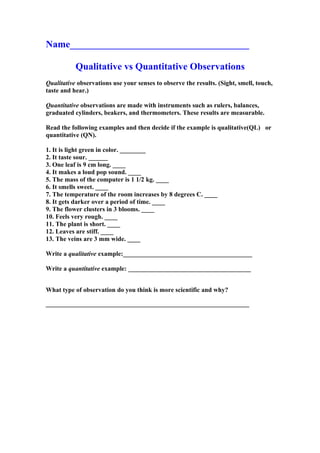Qualitative vs quantitative observations
•Télécharger en tant que DOC, PDF•
3 j'aime•3,144 vues
Signaler
Partager
Signaler
Partager

Recommandé
Contenu connexe
Tendances
Tendances (20)
Lesson 4 Characteristics, Strengths, and Weaknesses of Qualitative Research.pptx

Lesson 4 Characteristics, Strengths, and Weaknesses of Qualitative Research.pptx
En vedette
En vedette (14)
Data Analysis week 8 presentation - Survey and Quantitative Observation Techn...

Data Analysis week 8 presentation - Survey and Quantitative Observation Techn...
Plus de Gaby De La Garza
Plus de Gaby De La Garza (20)
Qualitative vs quantitative observations
- 1. Name_____________________________________ Qualitative vs Quantitative Observations Qualitative observations use your senses to observe the results. (Sight, smell, touch, taste and hear.) Quantitative observations are made with instruments such as rulers, balances, graduated cylinders, beakers, and thermometers. These results are measurable. Read the following examples and then decide if the example is qualitative(QL) or quantitative (QN). 1. It is light green in color. ________ 2. It taste sour. ______ 3. One leaf is 9 cm long. ____ 4. It makes a loud pop sound. ____ 5. The mass of the computer is 1 1/2 kg. ____ 6. It smells sweet. ____ 7. The temperature of the room increases by 8 degrees C. ____ 8. It gets darker over a period of time. ____ 9. The flower clusters in 3 blooms. ____ 10. Feels very rough. ____ 11. The plant is short. ____ 12. Leaves are stiff. ____ 13. The veins are 3 mm wide. ____ Write a qualitative example:________________________________________ Write a quantitative example: ______________________________________ What type of observation do you think is more scientific and why? _______________________________________________________________
